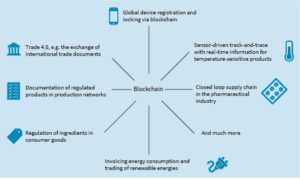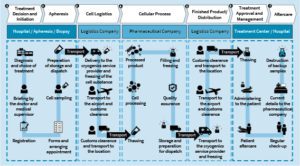This blog post is an article from a series of articles on the book published in December 2019 “Blockchain with SAP” (Rheinwerk publishing, Bonn, ISBN 978-3-8362-6914-8).
This blog post concerns the fourth chapter in the book, which deals with the cross-section of business application scenarios for blockchains.
Digital supply chains
The basic subject of this post is the challenges faced by modern digital supply chains and products. Issues such as traceability of goods, the quality control of products, protection against theft, inclusion of external partners and processes in internal systems, and the fight against forgery are only a few of the issues it tackles.
The inclusion of data from external partners in internal processes is one of the key problems which blockchain-based solutions are best-equipped to help with since they enable traceable distribution of controls and reciprocal monitoring of partners. Thanks to the use of smart contracts, it allows external participants to be involved in internal processes and take part in overall processes. The advantages are obvious: processes become faster, more transparent and, where required, are easier to trace.
Track-and-trace scenarios
The typical and surely the most simple to understand scenario for a blockchain is recording the temperature of a cold chain using sensors and a blockchain – known as track-and-trace. Highly perishable foods such as fish, meat, and milk require continuous temperature recording in order to guarantee the quality of the products. Sensors help with the regular capturing of data, which is stored in the blockchain safe from forgery and for verification purposes.

Blockchain
This scenario can be transferred to other areas – it repeatedly records and saves digital twins of the products. One modified application option for this, for example, is the recording of mileages and service intervals for vehicles.

Fight against counterfeit drugs
The black market in counterfeit medical products is huge, and even puts patients’ lives at risk if too weak or even counterfeit active ingredients have been used in the counterfeit products. Even here, blockchain-based solutions can help to assure the end user of the authenticity of the goods and to protect against forgeries. The opportunities include the storage of various different raw material information (ingredients, origin, shelf life), the traceability of the production process, the identification of individual batch numbers, and the final authentication control by the end user for the purchased product, such as by smartphone.
Protection against theft
In conjunction with SAP and Camelot IT Lab, Deutsche Telekom has implemented a blockchain-based IMEI tracker which records the unique smartphone device identity and traces the ownership of the device. If required, the device can be reported to the operator as stolen. This stops the device from being registered on the mobile network and becomes worthless to the thief. More information is available in this article by Forbes and in the blog entry by Andreas Göbel.
Blockchains change from decentralized account books into process control entities
Blockchains have developed enormously over recent years. While, to begin with, they were largely viewed as being forgery-safe data stores, since the introduction of smart contracts they have seen a slow change towards becoming workflow orchestration in which the secure storage of data only plays a subordinate role. The programmability and flexibility it provides are increasingly brought to the fore and turn the blockchains into control bodies for complex processes.
Example port management
Modern container ports are a cooperation of many different parties with divergent interests. The dispatcher wants to ship out or collect his goods quickly, the shipping company wants its ships to be loaded and unloaded as quickly as possible, customs have to meet their obligations, and management would like to have continuous oversight so that they can safely operate the port. A blockchain helps to coordinate these (legitimate) interests of all parties while watching over the compliance with individual processes. Everything is interlinked – the ship informs the dispatcher who has in turn already informed customs about the consignment. Necessary approvals and documents are digitally processed and stored in the blockchain, which watches over the correct procedure during dispatch or deletion of a loading and informs the individual entities. The solution is operated by the port management which maintains an overview and is able to intervene at all times.
This leads to smoother and therefore faster processes, a better utilization of the port, and to secure and transparent processes.
Examples of personalized medicines
In the field of personalized medicine, medication is tailored to the patient. These so-called closed-loop supply chains are therefore extremely important. They can also be implemented very successfully with the help of blockchains. The new medical procedures involve taking blood and tumor tissue from patients and then sequencing and analyzing these to develop a treatment that is precisely tailored to the patient’s illness or cancer. The resulting medication is only effective for this one patient, so it must be ensured that no samples or products are mixed up which, in the worst case scenario, could have lethal consequences. The figure below gives an impression of these complex processes and the people involved.

Blockchain-based products such as Hypertrust Platform help to adhere to these complex process chains and the proper processing of each step, while complying to any supplemental framework parameters such as temperature or adhering to time windows constraints. Blockchain also ensures that each patient receives only the medication intended for them.
Regulation of ingredients
The supply chains of today’s consumer goods are complex. To ensure continuous compliance with new regulations, a manufacturer has to know what contents are in their products and where they originate. When problems arose in the past, manufacturers had to carry out painstaking research into where the raw materials used came from and who supplied them, often shutting down the production for months.
Blockchain technology can help, by digitally including all suppliers and offering them a platform for publicizing the ingredients. In case of questions or problems, instant digital checks can be made as to which ingredients originate from which supplier. Working in conjunction with so-called trusted computing appliances, these checks can be performed while maintaining the intellectual property and recipes of the suppliers secret.

More articles of this series can be found here:
- Blockchain with SAP: What is Blockchain and How Does It Work?
- Blockchain with SAP: Blockchain-as-a-Service Products from the SAP Cloud Platform
- Blockchain with SAP: Cloud Computing from SAP: The SAP Cloud Platform
- Blockchain with SAP: The First Steps to Having Your Own Blockchain
- Blockchain with SAP: Developing Applications with Hyperledger Fabric
- Blockchain with SAP: Developing Blockchain Applications with Hyperledger Fabric
- Blockchain with SAP: SAP HANA Integration
- Blockchain with SAP: MultiChain Applications
- Blockchain with SAP: MultiChain Applications
- Blockchain with SAP: Hybrid Network Architecture and Camelot Hypertrust Platform
- Blockchain with SAP: Summary and outlook

Would you like to find out more about blockchains and distributed ledger technologies? Would you like to know how you can modernize your company and make it fit for the future? Is a blockchain really the right choice for your business processes? In our book “Blockchain with SAP,” we explain various areas of application and scenarios in detail and give you a decision list that you can use to check whether a blockchain is the right choice for your company. A detailed extract of the book is available online from the publisher.
